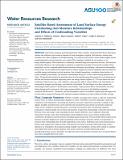Satellite‐Based Assessment of Land Surface Energy Partitioning–Soil Moisture Relationships and Effects of Confounding Variables
Author(s)
Feldman, Andrew F; Gianotti, Daniel J; Trigo, Isabel F.; Salvucci, Guido D.; Entekhabi, Dara
DownloadPublished version (8.958Mb)
Publisher with Creative Commons License
Publisher with Creative Commons License
Creative Commons Attribution
Terms of use
Metadata
Show full item recordAbstract
Land surface energetic partitioning between latent, sensible, and ground heat fluxes determines climate and influences the terrestrial segment of land-atmosphere coupling. Soil moisture, among other variables, has a direct influence on this partitioning. Dry surfaces characterize a water-limited regime where evapotranspiration and soil moisture are coupled. This coupling is subdued for wet surfaces, or an energy-limited regime. This framework is commonly evaluated using the evaporative fraction–-soil moisture relationship. However, this relationship is explicitly or implicitly prescribed in land surface models. These impositions, in turn, confound model-based evaluations of energetic partitioning-–soil moisture relationships. In this study, we use satellite-based observations of surface temperature diurnal amplitude (directly related to available energy partitioning) and soil moisture, free of model impositions, to estimate characteristics of surface energetic partitioning–-soil moisture relationships during 10–-20-day surface drying periods across Africa. We specifically estimate the spatial patterns of water-limited energy flux sensitivity to soil moisture (m) and the soil moisture threshold separating water and energy-limited regimes (θ*). We also assess how time evolution of other factors (e.g., solar radiation, vapor pressure deficit, surface albedo, and wind speed) can confound the energetic partitioning–-soil moisture relationship. We find higher m in drier regions and interestingly similar spatial θ* distributions across biomes. Vapor pressure deficit and insolation increases during drying tend to increase m. Only vapor pressure deficit increases in the Sahelian grasslands systematically decrease θ*. Ultimately, soil and atmospheric moisture availability together play the largest role in land surface energy partitioning with minimal consistent influences of time evolution of other forcings. ©2019. The Authors.
Date issued
2019-12Department
Massachusetts Institute of Technology. Department of Civil and Environmental EngineeringJournal
Water Resources Research
Publisher
American Geophysical Union (AGU)
Citation
Feldman, Andrew F. et al., "Satellite‐Based Assessment of Land Surface Energy Partitioning–Soil Moisture Relationships and Effects of Confounding Variables." Water Resources Research 55, 12 (December 2019): 10657-77 doi. 10.1029/2019WR025874 ©2019 Authors
Version: Final published version
ISSN
1944-7973